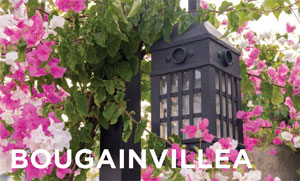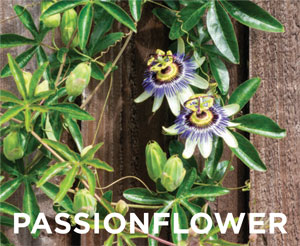Trailing Upward | Climbing Vines Embellish a Garden

Climbing vines are a great addition to the garden. Some selections offer gorgeous bursts of long-lasting color; others provide lush green foliage most of the year. Trained onto metal or wooden lattice forms, vines provide coverage for unsightly spaces or add interest to bare areas. A climbing vine on a trellis can hide unattractive compressor units or trashcans. Plant one to wander up and over an arbor for a stunning entrance to the garden. Some vines are sold as seed, others as potted stock at your local nursery. Vines present every level of gardeners with exciting design options.
When looking for notable vines that thrive in our climate, consider the location first. Is it full sun? Does it provide afternoon shade? Is the soil well-drained or is it sandy and boggy? Choose vines that work best for your landscape and gardening style, then consider flower color. Here are options for flowering vines that grow well in our area along with their assets and needs. These loyal bloomers provide stunning flowers and heavy coverage once established.
 Climbing Roses: These old-fashioned favorites want at least six hours of sun each day. Plant them on an arbor or trellis three feet or more away from a wall for good air circulation, which wards off diseases. Climbing roses come in various shades of whites, yellows, pinks and reds, and grow higher each year. Planted in a mixture of equal parts clay, coarse sand and decomposed organic matter, roses thrive and bestow vibrant blooms. Prune and tie the tiny ends of the vine (tendrils) on the arbor periodically to maintain a willowy appearance.
Climbing Roses: These old-fashioned favorites want at least six hours of sun each day. Plant them on an arbor or trellis three feet or more away from a wall for good air circulation, which wards off diseases. Climbing roses come in various shades of whites, yellows, pinks and reds, and grow higher each year. Planted in a mixture of equal parts clay, coarse sand and decomposed organic matter, roses thrive and bestow vibrant blooms. Prune and tie the tiny ends of the vine (tendrils) on the arbor periodically to maintain a willowy appearance.
 Clematis: This quintessential garden staple offers stunning flower colors and shapes for many years. From purples to blues, pinks, yellows and whites to various multi-color petal combinations, these flowers are eye-catching beauties in shapes that range from stars to frilly clusters to bell-shaped flowers. Clematis flourish in rich, moist, well-drained soil that is amended with compost and wood ash. They require a trellis as the vines are delicate and need a place to attach and twine. Take a British tip and plant two varieties on one arbor; watch the colors overlap in a vibrant display.
Clematis: This quintessential garden staple offers stunning flower colors and shapes for many years. From purples to blues, pinks, yellows and whites to various multi-color petal combinations, these flowers are eye-catching beauties in shapes that range from stars to frilly clusters to bell-shaped flowers. Clematis flourish in rich, moist, well-drained soil that is amended with compost and wood ash. They require a trellis as the vines are delicate and need a place to attach and twine. Take a British tip and plant two varieties on one arbor; watch the colors overlap in a vibrant display.
 Black-Eyed Susan vine: Plant the seeds of this annual beauty inside each spring six to eight weeks before the last frost, then transplant to the garden. The yellow-orange flowers with black centers are perfect for hanging baskets or pots on a shelf. Native to India, the British brought seeds to Virginia as they suit our climate. These charming flowers prefer morning sun, afternoon shade, and well-drained potting soil. They do not like intense heat. Another variety comes in blush, pink and salmon petals with traditional black centers.
Black-Eyed Susan vine: Plant the seeds of this annual beauty inside each spring six to eight weeks before the last frost, then transplant to the garden. The yellow-orange flowers with black centers are perfect for hanging baskets or pots on a shelf. Native to India, the British brought seeds to Virginia as they suit our climate. These charming flowers prefer morning sun, afternoon shade, and well-drained potting soil. They do not like intense heat. Another variety comes in blush, pink and salmon petals with traditional black centers.
 Carolina Yellow Jasmine: Yellow blooms burst forth from a mass of lush green foliage. This vine grows quickly and is a good cover for camouflaging a chain link fence or brightening a mailbox post. Give it a spot in full sun with moist, rich organic soil that drains well, and it rewards year after year with blooms aplenty. Fertilize each spring and again midsummer with a slow-release fertilizer. It is a heavy plant that requires a strong arbor, or train it on a trellis in front of a brick wall for a spectacular color combination. Trim the tendrils after the flowers are spent if it needs shaping.
Carolina Yellow Jasmine: Yellow blooms burst forth from a mass of lush green foliage. This vine grows quickly and is a good cover for camouflaging a chain link fence or brightening a mailbox post. Give it a spot in full sun with moist, rich organic soil that drains well, and it rewards year after year with blooms aplenty. Fertilize each spring and again midsummer with a slow-release fertilizer. It is a heavy plant that requires a strong arbor, or train it on a trellis in front of a brick wall for a spectacular color combination. Trim the tendrils after the flowers are spent if it needs shaping.
 Climbing Hydrangea: Vigorous and bushy with beautiful white or blush blooms, a climbing hydrangea grows slowly the first few years then leaps into a large mass of showy flowers. These perennial vines require large spaces as once established, some grow from 24 feet wide to 39 feet tall. Climbing hydrangea favor a wall or trellis where their aerial roots (roots above the ground) attach easily. Plant in rich, moist soil full of compost. Climbing hydrangea prefer lots of sun and some afternoon shade. Keep them well watered so their leaves don’t droop.
Climbing Hydrangea: Vigorous and bushy with beautiful white or blush blooms, a climbing hydrangea grows slowly the first few years then leaps into a large mass of showy flowers. These perennial vines require large spaces as once established, some grow from 24 feet wide to 39 feet tall. Climbing hydrangea favor a wall or trellis where their aerial roots (roots above the ground) attach easily. Plant in rich, moist soil full of compost. Climbing hydrangea prefer lots of sun and some afternoon shade. Keep them well watered so their leaves don’t droop.
 Bougainvillea: This impressive plant with glossy green leaves hails from the tropics, so grow it in large pots to keep it blooming. It dazzles with fabulous purple, red or deep-pink flowers that give a romantic vibe to the garden. Its vines must be tied to a strong trellis or arbor; metal is best. It likes full sun and gritty, loose soil that goes dry between waterings. Temperatures under 25 degrees will kill it, but bougainvillea grows to an impressive shrub of several feet if overwintered inside.
Bougainvillea: This impressive plant with glossy green leaves hails from the tropics, so grow it in large pots to keep it blooming. It dazzles with fabulous purple, red or deep-pink flowers that give a romantic vibe to the garden. Its vines must be tied to a strong trellis or arbor; metal is best. It likes full sun and gritty, loose soil that goes dry between waterings. Temperatures under 25 degrees will kill it, but bougainvillea grows to an impressive shrub of several feet if overwintered inside.
 Passionflower: These sturdy vines grace the garden with flowers from midsummer until first frost. For maximum flowering, give passionflower six full hours of sun, and plant them directly in well-draining, rich, moist soil. The unusual flowers in whites, purples, blues, reds and pinks last only for a day and are popular with pollinators. The tendrils will cling to a fence or arbor, and fertilizing every four to six weeks makes them prosper. Passionflowers do not need deadheading and only require pruning to remove dead stems and make the plant bushier.
Passionflower: These sturdy vines grace the garden with flowers from midsummer until first frost. For maximum flowering, give passionflower six full hours of sun, and plant them directly in well-draining, rich, moist soil. The unusual flowers in whites, purples, blues, reds and pinks last only for a day and are popular with pollinators. The tendrils will cling to a fence or arbor, and fertilizing every four to six weeks makes them prosper. Passionflowers do not need deadheading and only require pruning to remove dead stems and make the plant bushier.
Morning Glory (an annual usually grown from seed that sprouts white or purple flowers), wisteria (a perennial vine that drapes clusters of purple flowers over arbors), English ivy (a perennial with waxy, green heart-shaped leaves) and honeysuckle (another perennial popular for its signature yellow or red trumpet shape blooms) are well-known vines often chosen for their durability and heavy coverage. These climbing vines are invasive so many gardeners are now limiting or removing them as they require constant pruning to keep them from overtaking other areas of the garden. Unchecked, these vines will train up walls, trees and houses, so do some research and know the disadvantages before inviting them into the garden.
Vines need care, but their heavy foliage and magnificent flowers are worth the effort. Pruning established vines several times per growing season is a must to keep them orderly and intact on the fence or arbor. Climbing vines, given good soil and loads of sunshine, reward with lush flowers in vivid colors that create a statement in the garden. ✦
Black-Eyed Susan vine, Carolina Yellow Jasmine, Clematis, Climbing Hydrangea, climbing roses, Climbing Vines, lattice forms






